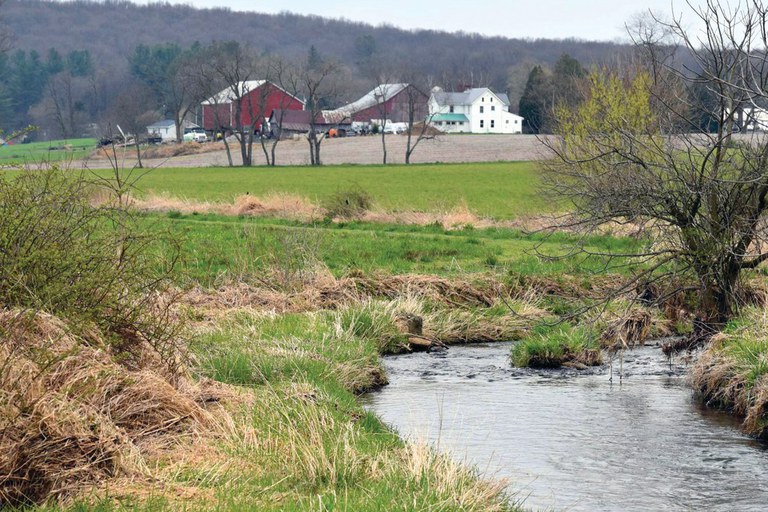Posted: March 17, 2022
Changing cropping systems in impaired watersheds can produce water quality gains in the Chesapeake Bay.

In the simulations, hay was reallocated onto landscapes most vulnerable to erosion and nutrient loss, such as the areas near streams, whereas corn-soybean rotations were reallocated onto less vulnerable areas. Photo: Patrick Drohan
Growing the right crop in the right place within an impaired watershed can achieve significant water quality improvements, according to Penn State researchers who conducted a novel study in the drainage of a Susquehanna River tributary in an agricultural area in southeastern Pennsylvania.
The research may reveal a potential path for restoring the troubled Chesapeake Bay, said Patrick Drohan, associate professor of pedology in the college and one of the study's authors. The bay--which has long been impaired in large part by nutrients and sediment washing off crop fields and getting into surface waters that feed it--needs bold solutions, such as changing cropping systems, he suggested.
"Other than when wastewater treatment plants came into compliance in the Chesapeake Bay watershed, no other 'practice' has been shown to have as large an effect on nitrogen, phosphorus, and sediment reductions as simply reallocating existing crop percentages to less risky landscapes," he said. "Even without additional best management practices, just moving row crops, such as corn and soybeans, away from streams and off steep slopes can make a huge difference."
Fei Jiang, a recent soil science doctoral degree graduate and current postdoctoral scholar in the Department of Entomology, deployed a powerful computer program called the Soil and Water Assessment Tool to model crop growth and losses of total nitrogen, total phosphorus, and sediment for an eight-year period, from 2010 to 2017.
Then, based on those model results, she developed an innovative algorithm to spatially reallocate crop rotations within existing agricultural land to reduce total nitrogen, total phosphorus, and sediment losses based on soil properties, while maintaining a similar production area for each rotation. Hay was reallocated onto landscapes most vulnerable to erosion and nutrient loss, whereas corn-soybean rotations were reallocated onto less vulnerable areas.
In findings recently published in Agricultural Systems, those crop reallocation simulations resulted in a 15 percent reduction in total nitrogen losses, a 14 percent reduction in total phosphorus losses, and a 39 percent reduction in sediment losses at an average annual scale across the watershed.
Considered to be a pollution "hot spot" in the Chesapeake Bay watershed, the Conewago Creek drainage was an ideal place to perform the experiment, Jiang noted. The stream carries high nutrient and sediment loads in a watershed with a high percentage of agricultural land use. She said she hopes the study opens a dialogue that results in real improvements for the bay.
"Originally, I worried that this research will be seen as too theoretical, that farmers will never change what they grow and where they grow it, and the research wouldn't have any real meaning," she said. "But given the sharp reductions in pollution that we have shown are possible with this fresh approach, I think people will be convinced to consider giving it a try. This model is actually doable in real life."
The results of this study suggest that redistributing crop rotations within the Chesapeake Bay watershed might achieve needed, substantial water quality benefits that so far have eluded policymakers implementing other practices, Drohan noted. "But the devil will be in the details."
--Jeff Mulhollem
Features
Fostering Forests
Across the United States, forests face unprecedented threats, and scientists in Penn State's College of Agricultural Sciences are conducting novel and complex research to conserve them.
Buzzing With Purpose
Community scientists work to protect Pennsylvania's wild bees
Conservation Reimagined
Exploring new approaches to cope with a changing climate


